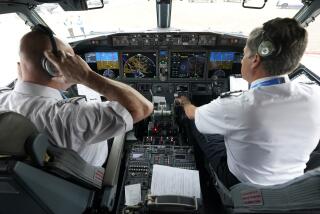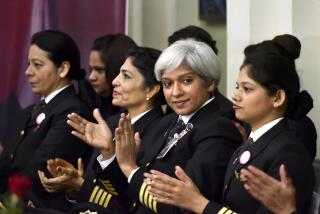Spotter Fishing for Commercial Pilot License
- Share via
Pamela Hengsteler, 42, goes fishing seven hours a day, seven days a week in a rented airplane.
Actually, she spots swordfish for fishermen who are bobbing along Catalina Island waiting for her radio message of a sighting.
“If they make a catch, I make a catch,” she said, pointing out that a good day is three swordfish, even though one would be OK. “I have to hope they have a good harpooner.”
Hengsteler said that if the fishermen end up with empty hooks, she ends up with an empty purse. “The fishermen pay for the plane rental if they hook the fish I spot,” she said. “Otherwise, I have to pay the rental and the gas.”
The rented plane is equipped with extra gas tanks for her seven-hour flights.
A good day means that she also gets a financial share of the swordfish which sells for around $12 a pound in some markets.
And a good swordfish can weigh 500 pounds.
Although there have been recent slim pickings in the ocean waters off Catalina where she flies, Hengsteler has an ulterior motive for her fish patrol.
“I need the flight time to qualify as an airline or corporate pilot,” said the Fountain Valley woman, who has 600 hours of flight time to her credit.
Commercial airlines require a minimum of 1,000 hours of flight time for its pilots,but “most airlines prefer 2,000 hours,” she said.
Fish spotting helps ring up free flight time, but they are tough flights.
“It’s difficult flying six or seven hours straight,” said Hengsteler, who was recently named Pilot of the Year by the Orange County Ninety-Nines, an organization of female pilots.
The group also presented Hengsteler a scholarship for flight instructors’ advanced training, another wAy for her to get flight time in by training others who want to be pilots.
Before she ran aCross the fish-spotting job, Hengsteler hand-washed planes to raise money for plane rentals.
She charged $35 to wash a small plane.
“I remember this guy walked up and asked if I would wash his plane, and I just about had a heart attack,” she said. “He had a twin-engine corporate jet that would have taken me two days to do. I declined.”
She called her service Pam’s Pretty Planes.
“I thought it was a catchy title,” she said, speaking softly with the remnants of her West Virginia twang.
Hengsteler said her yearning to fly started at age 12.
“There was a grass landing strip near our home, and I would watch the planes land and take off, and it excited me,” she said. “I lived in an extremely rural area in West Virginia and didn’t think I’d ever get out of there.”
Hengsteler, who attended West Virginia University, Orange Coast College and UC Irvine, admits that she is a Pamela-come-lately since she didn’t start flying until five years ago because she couldn’t afford flying lessons.
After college she took jobs waitressing, singing and working as a professional photographer to save money for flying lessons. “I sometimes would sing at the wedding where I took the pictures,” she said.
Besides flying, “my other ambition was to do a combination Julie Andrews-Barbra Streisand singing thing.” She said that didn’t work out.
Now her goals are set in the air.
“There’s no question about my life,” said the wife of David Hengsteler Jr., a lighting electrician for Paramount Studios. “I want to be a commercial pilot.”
Actually, she would rather fly jets for a private business.
“They usually have a more balanced work schedule than the commercial airline. It’s almost like having an 8-to-5 job with better pay, hours and job security,” she said.
Acknowledgments--Tustin resident Joseph E. Irvine, executive director of the Orange County Aviation Council, has been presented the annual Wannamaker Award from the California Assn. of Airport Executives. It is given to a person who “makes a substantial contribution to air transportation.” The council was formed in 1974 by business and civic leaders and has been a continual advocate of improved air transportation for Orange County.
More to Read
Sign up for Essential California
The most important California stories and recommendations in your inbox every morning.
You may occasionally receive promotional content from the Los Angeles Times.













